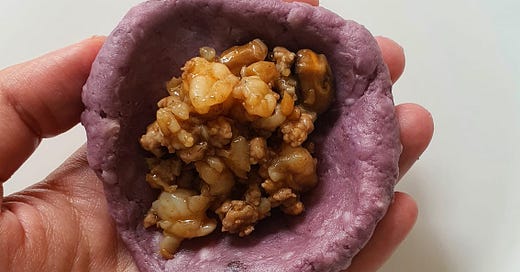Before we dive into the recipe, let me address a few questions that I anticipate:
Can I substitute wheat starch for another type of starch? No! Wheat starch behaves differently from other starches. Pour boiling water over potato starch, for example, and you’ll get a sticky gloop. The same boiling water poured over wheat starch will give you a malleable dough. You’ll find this ingredient in packets, alongside other starches such as cornstarch and potato starch at the Asian grocer.
What is taro and what should I look out for when selecting one? If you have never worked with taro, it is a root vegetable that is often incorrectly referred to as “yam”. At the market, vendors know that starchy taros are coveted and will help you select one. A starchy taro has a lower water content and has a powdery texture akin to egg yolks when cooked. To tell if the taro that you’ve bought is starchy, slice into it and see if there is a starchy residue on your knife. It is also better to use the centre of the taro for this recipe as the ends are less starchy. That said, the starchiness of the taro will not make or break your croquettes. The only difference, in my opinion, is that a starchy taro mashes easily when steamed so you wouldn’t have chunks of unmashed taro in your croquette dough.
Now onto the recipe! This recipe makes 9-10 croquettes. These are filling and substantial but Wex is able to polish off 3 at one go on his own, so scale the recipe up or down accordingly.




